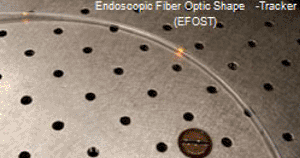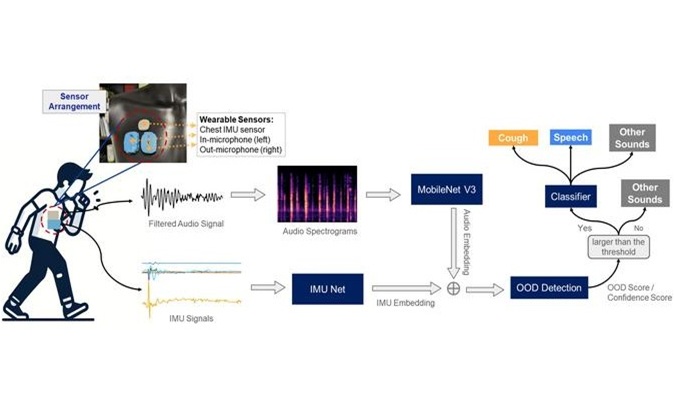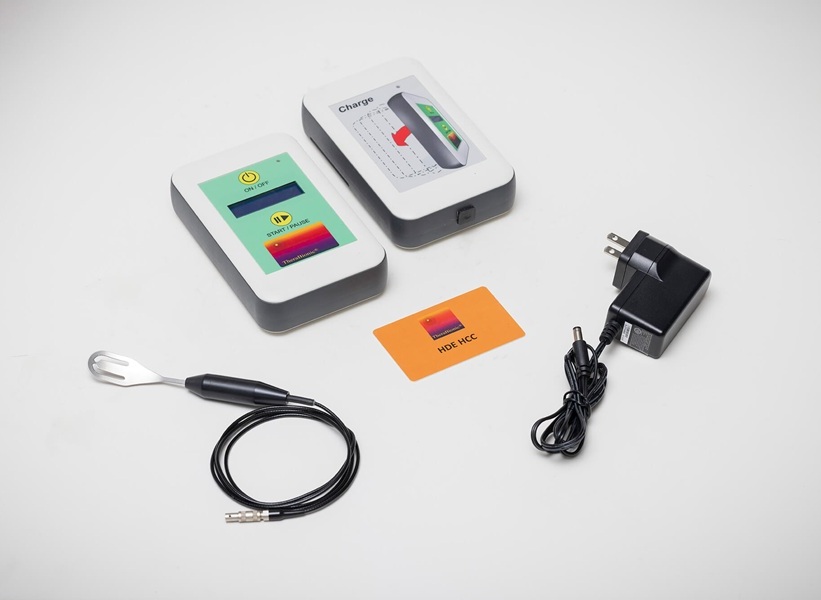Optical Device Offers Less Painful Colonoscopy
|
By HospiMedica International staff writers Posted on 09 May 2011 |

Image: Quantum dots lighting up with the EFOST (Photo courtesy of Tufts University).
A colonoscopy device under development could help reduce patient discomfort while still ensuring the accuracy of the exam procedure.
Researchers at Tufts University (Medford, MA, USA) developed endoscopic fiber optic shape tracker (EFOST) technology as a possible solution to the problem that occurs when the endoscope is inserted into the colon during a routine screening. As the endoscope is navigated through the bends and turns in the colon, its tip can impinge against the colon wall. When this happens, the tip turns stationary; if the physician applies more pressure, a loop can form in the length of scope behind the tip. Since the traditional endoscope provides only a frontal view during the procedure, the doctor cannot see the loop, nor easily maneuver the scope to remove it. As a result, looping can be a major source of pain during a colonoscopy.
The researchers developed a prototype to overcome this problem, by embedding quantum dots--nano-sized crystals of semiconductor material--circumferentially at intervals along the length of an optical fiber. They then stretched the fiber around a metal cylinder to create a bending effect, and injected a laser light beam into the fiber's inner core from one end; the fiber's core released light as it is bent, activating the quantum dots. Instantly, the dots reemitted light signals of varying intensity to a spectrometer; using this data, the researchers were able to measure the degree of curvature in the fiber. And from the position of the activated dots, the researchers were also able to calculate the direction of the bend.
"Doctors will have a way to see in real-time how the scope is moving inside the body. If the scope begins to loop, they will see it instantaneously and then be able to make adjustments to straighten it out,” said lead researcher associate professor of mechanical engineering Caroline Cao, PhD. "Physicians can use the image on the monitor to guide them. They'll know exactly where the end of the point is, as well as the shape of the scope inside the colon.”
Colonoscopy is the examination of the colon and the distal part of the small bowel with a video camera or a fiber optic camera on a flexible endoscope passed through the anus. It may provide a visual diagnosis (e.g., ulceration, polyps) and grants the opportunity for biopsy or removal of suspected lesions. Virtual colonoscopy, which uses imagery reconstructed from computed tomography (CT) scans or from nuclear magnetic resonance (MR) scans, is also possible, as a totally noninvasive medical test, although it is not standard and still under investigation regarding its diagnostic abilities.
Related Links:
Tufts University
Researchers at Tufts University (Medford, MA, USA) developed endoscopic fiber optic shape tracker (EFOST) technology as a possible solution to the problem that occurs when the endoscope is inserted into the colon during a routine screening. As the endoscope is navigated through the bends and turns in the colon, its tip can impinge against the colon wall. When this happens, the tip turns stationary; if the physician applies more pressure, a loop can form in the length of scope behind the tip. Since the traditional endoscope provides only a frontal view during the procedure, the doctor cannot see the loop, nor easily maneuver the scope to remove it. As a result, looping can be a major source of pain during a colonoscopy.
The researchers developed a prototype to overcome this problem, by embedding quantum dots--nano-sized crystals of semiconductor material--circumferentially at intervals along the length of an optical fiber. They then stretched the fiber around a metal cylinder to create a bending effect, and injected a laser light beam into the fiber's inner core from one end; the fiber's core released light as it is bent, activating the quantum dots. Instantly, the dots reemitted light signals of varying intensity to a spectrometer; using this data, the researchers were able to measure the degree of curvature in the fiber. And from the position of the activated dots, the researchers were also able to calculate the direction of the bend.
"Doctors will have a way to see in real-time how the scope is moving inside the body. If the scope begins to loop, they will see it instantaneously and then be able to make adjustments to straighten it out,” said lead researcher associate professor of mechanical engineering Caroline Cao, PhD. "Physicians can use the image on the monitor to guide them. They'll know exactly where the end of the point is, as well as the shape of the scope inside the colon.”
Colonoscopy is the examination of the colon and the distal part of the small bowel with a video camera or a fiber optic camera on a flexible endoscope passed through the anus. It may provide a visual diagnosis (e.g., ulceration, polyps) and grants the opportunity for biopsy or removal of suspected lesions. Virtual colonoscopy, which uses imagery reconstructed from computed tomography (CT) scans or from nuclear magnetic resonance (MR) scans, is also possible, as a totally noninvasive medical test, although it is not standard and still under investigation regarding its diagnostic abilities.
Related Links:
Tufts University
Latest Surgical Techniques News
- Novel Glue Prevents Complications After Breast Cancer Surgery
- Breakthrough Brain Implant Enables Safer and More Precise Drug Delivery
- Bioadhesive Sponge Stops Uncontrolled Internal Bleeding During Surgery
- Revolutionary Nano Bone Material to Accelerate Surgery and Healing
- Superior Orthopedic Implants Combat Infections and Quicken Healing After Surgery
- Laser-Based Technique Eliminates Pancreatic Tumors While Protecting Healthy Tissue
- Surgical Treatment of Severe Carotid Artery Stenosis Benefits Blood-Brain Barrier
- Revolutionary Reusable Duodenoscope Introduces 68-Minute Sterilization
- World's First Transcatheter Smart Implant Monitors and Treats Congestion in Heart Failure
- Hybrid Endoscope Marks Breakthrough in Surgical Visualization
- Robot-Assisted Bronchoscope Diagnoses Tiniest and Hardest to Reach Lung Tumors
- Diamond-Titanium Device Paves Way for Smart Implants that Warn of Disease Progression
- 3D Printable Bio-Active Glass Could Serve as Bone Replacement Material
- Spider-Inspired Magnetic Soft Robots to Perform Minimally Invasive GI Tract Procedures
- Micro Imaging Device Paired with Endoscope Spots Cancers at Earlier Stage
- AI Spine Model Could Reduce Surgical Risks
Channels
Critical Care
view channel
Origami Robots to Deliver Medicine Less Invasively and More Effectively
Delivering medicine to ulcers or other internal sites often requires invasive procedures that can disrupt surrounding tissues and lengthen recovery times. Traditional magnetic actuators used in soft robotics... Read more
Improved Cough-Detection Technology Aids Health Monitoring
Coughing serves as an important biomarker for tracking a variety of conditions and can help monitor the progress of respiratory diseases or predict when someone’s asthma is being exacerbated.... Read morePatient Care
view channel
Revolutionary Automatic IV-Line Flushing Device to Enhance Infusion Care
More than 80% of in-hospital patients receive intravenous (IV) therapy. Every dose of IV medicine delivered in a small volume (<250 mL) infusion bag should be followed by subsequent flushing to ensure... Read more
VR Training Tool Combats Contamination of Portable Medical Equipment
Healthcare-associated infections (HAIs) impact one in every 31 patients, cause nearly 100,000 deaths each year, and cost USD 28.4 billion in direct medical expenses. Notably, up to 75% of these infections... Read more
Portable Biosensor Platform to Reduce Hospital-Acquired Infections
Approximately 4 million patients in the European Union acquire healthcare-associated infections (HAIs) or nosocomial infections each year, with around 37,000 deaths directly resulting from these infections,... Read moreFirst-Of-Its-Kind Portable Germicidal Light Technology Disinfects High-Touch Clinical Surfaces in Seconds
Reducing healthcare-acquired infections (HAIs) remains a pressing issue within global healthcare systems. In the United States alone, 1.7 million patients contract HAIs annually, leading to approximately... Read moreHealth IT
view channel
Printable Molecule-Selective Nanoparticles Enable Mass Production of Wearable Biosensors
The future of medicine is likely to focus on the personalization of healthcare—understanding exactly what an individual requires and delivering the appropriate combination of nutrients, metabolites, and... Read moreBusiness
view channel
Philips and Masimo Partner to Advance Patient Monitoring Measurement Technologies
Royal Philips (Amsterdam, Netherlands) and Masimo (Irvine, California, USA) have renewed their multi-year strategic collaboration, combining Philips’ expertise in patient monitoring with Masimo’s noninvasive... Read more
B. Braun Acquires Digital Microsurgery Company True Digital Surgery
The high-end microsurgery market in neurosurgery, spine, and ENT is undergoing a significant transformation. Traditional analog microscopes are giving way to digital exoscopes, which provide improved visualization,... Read more
CMEF 2025 to Promote Holistic and High-Quality Development of Medical and Health Industry
The 92nd China International Medical Equipment Fair (CMEF 2025) Autumn Exhibition is scheduled to be held from September 26 to 29 at the China Import and Export Fair Complex (Canton Fair Complex) in Guangzhou.... Read more














